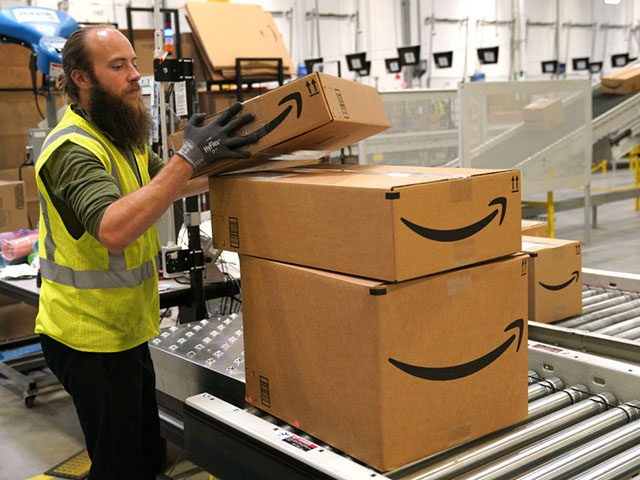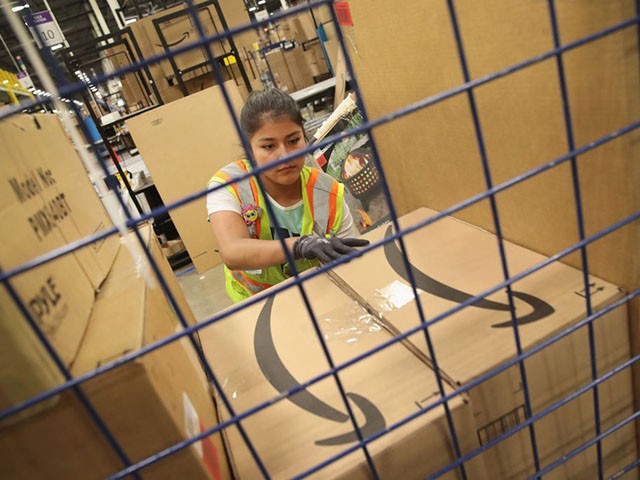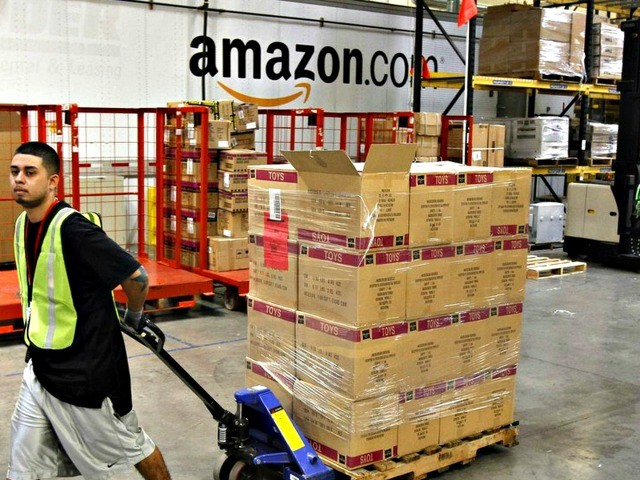The lessons of the failed Amazon Labor Union campaign in Albany, New York
On Tuesday, the National Labor Relations Board (NLRB) announced that Amazon workers at the company’s facility in Albany, New York voted against unionizing with the Amazon Labor Union (ALU) by a two-to-one margin, with 406 workers voting “no” and only 206 voting “yes.”
The vote did not fail because workers at the warehouse are satisfied with the conditions forced upon them by one of the most exploitative and powerful corporations in the world. On the contrary, the Albany warehouse (known as ALB1) is among the most dangerous Amazon facilities in the country, and rank-and-file opposition to low wages, unsafe conditions and routine violation of their rights is widespread.
The warehouse is a special “oversize” warehouse where workers handle heavy equipment like televisions, outdoor equipment and furniture. According to a report published recently by the National Employment Law Project (NELP), the Albany warehouse is the most dangerous Amazon warehouse in New York State, with a massive 22.3 injuries per 100 full-time workers.
In 2021, a staggering 212 of the 951 workers at the warehouse were injured, more than the total number of workers who voted for the ALU and a rate almost four times worse than the second most dangerous Amazon warehouse in the state. Over the course of last year, 188 workers were seriously injured, at a rate of 19.8 serious injuries per 100. In other words, an Albany Amazon worker’s chance of getting seriously injured on the job in the course of one year’s work under current conditions is one in five.
COVID-19 spread through ALB1 and other Amazon warehouses in the spring of 2022, but Amazon cut COVID pay for workers in the US in May, with Amazon posting signs in the facility that said “No Covid pay, no excuses.”
On the eve of last week’s election, a fire broke out at the warehouse, threatening workers’ lives and prompting them to leave the building. It was the third fire at a New York Amazon facility in the span of a week. A large group of workers at ALU-organized JFK8 walked out of their facility just days before the fire at ALB1 and in the lead-up to the vote. Despite the extraordinary danger of working at the Albany facility, wages remain exceptionally low, with workers starting at just $17 an hour amid 9 percent inflation.
Under these explosive conditions, the ALU failed to win votes from even a quarter of the total workforce. It was the worst vote total of any Amazon unionization drive to date.
The consistent decline in support from vote to vote cannot be explained away by claims of antidemocratic interference by Amazon, which has been a constant at all of the ALU elections and does not compare to the open violence that the union movements overcame in the 19th and 20th centuries. The ALU has appealed the ALB1 election outcome, but instead of calling for a revote, it has simply called for Biden’s NLRB to override the “no” vote and directly order Amazon to accept a union at the facility.
The decline in support for the ALU is the product of its strategy, which was not connected to any clear appeal to the rank-and-file workers based on a set of demands the union would fight for if elected. The ALU made no real effort to convince workers that they had any strategy to fight the company.
Its website’s section about the ALB1 election includes no demands and is comprised entirely of vague statements like: “Amazon is a company with deeply-rooted issues and management always prioritizes profits over people.” The ALU’s explanation of why workers are attempting to unionize is because “we should have a seat at the table and be able to negotiate better pay, benefits and working conditions.” A separate section of the website called “what we are fighting for” includes no concrete demands on the company.
Instead of appealing to workers’ independent strength, the ALU regularly promoted Democratic Party politicians as allies of Amazon workers in the run-up to the vote. On social media, it shared statements from New York Democratic Party politicians as well as from Vermont Senator Bernie Sanders, who caucuses with the Democrats, and who recorded a brief video supporting the ALU effort at Albany.
In its first election at JFK8, in the face of equal pressure from the company, workers voted to unionize with the ALU because they saw the ALU as distinct from the AFL-CIO bureaucracy which Amazon workers twice rejected at unionization votes with the Retail, Wholesale and Department Store Union (RWDSU) at Bessemer, Alabama.
But since the JFK8 victory, the ALU has publicly associated itself with the leadership of the AFL-CIO, with organizations like the Teamsters and its president, Sean O’Brien, and with the Democratic Party and the Biden administration. It has undermined its past claims to “independence” and has not attempted to appeal to the workers at JFK8 for an open struggle against Amazon, instead telling workers they must wait for the NLRB appeals process to exhaust before they fight for a new contract.
This is the first ALU unionization election since ALU leader Chris Smalls met with Joe Biden in the White House in May. Biden has repeatedly thrown his political capital behind the effort to unionize Amazon. In May, after the ALU’s victory at JFK8, Biden embraced Smalls and said, “You’ve done it in one place, let’s not stop.”
The ALU’s increasingly close connections to the Democratic Party and the AFL-CIO bureaucracy resulted in a decline in its support among rank-and-file workers, who view the AFL-CIO as responsible for overseeing decades of attacks on jobs and living conditions, especially in industrial areas of the Midwest and upstate New York.
This fact was hinted at in an October 11 New York Times article which reads: “According to government data, Albany is one of the most unionized metropolitan areas in the country, and many employees expressed positive views about unions. But some said past experience at unionized workplaces made them less eager to join another one.”
Across Amazon facilities and at a growing number of workplaces in every industry around the world, rank-and-file workers are looking for a way to harness their potential strength and fight the transnational corporations, whose profits are soaring as workers confront rising living costs on every continent. The perspective of the ALU is to harness workers to the union apparatus, which the Biden administration backs as a critical instrument not only for the suppression of the class struggle, but for waging war abroad.
A real fight of Amazon workers and all sections of the working class requires the mobilization of the rank and file against the apparatus of the trade unions, whose army of bureaucrats enrich themselves by leeching off of workers’ dues and exist to police the workforce.
The most conscious expression of this is the campaign of 34-year-old socialist Mack Trucks worker Will Lehman for president of the UAW, where direct elections are being held only because the past leadership of the UAW was thrown in jail for accepting corporate bribes in exchange for selling out workers.
The purpose of Lehman’s campaign is to develop a mass movement to abolish the corrupt UAW bureaucracy and transfer power to the workers on the shop floor. Lehman is not running to join the bureaucracy or reform it from within, but to unlock the independent strength of the working class in the auto industry and across all industries in an international struggle against the global corporations.
‘Off the Charts:’ Data Shows Amazon’s Speed Targets Greatly Increase Risk of Worker Injury

Data collected through workplace inspections at Amazon warehouse facilities found that the company’s pace of work greatly increases the risk of injury for its employees. Workplace regulators reportedly say that the risk of debilitating muscle and joint injuries is off the charts.
Moreover, because these injuries build up over time, Amazon employees may not know they are at risk until months or even years later, and they can end up being left with a lifetime of pain, according to a report by Business Insider.
The most detailed investigation into Amazon’s workplace injury epidemic has been conducted in Washington state, due to the state workers’ compensation system collecting detailed data on work-related muscle and joint injuries in the United States.
A “direct connection” between Amazon’s fast work pace and the company’s high injury rates was found, according to data from inspections conducted in Washington state over the past two years.
The inspection was reportedly sparked by data published in 2020 by Reveal at the Center for Investigative Reporting, which showed that Amazon warehouse workers nationwide were twice as likely to get seriously hurt, when compared to warehouse workers at other companies.
“Seriously hurt” refers to workplace injuries that keep employees from doing their usual jobs.
Amazon reportedly reacted to the investigation conducted by Washington state regulators by saying that its own analysis of the data found substantially lower injury risks.
Mark Takakura, a former U.S. Army medic who started working at Amazon in September 2020, told Business Insider that the company “told us numerous times, if you need to slow down to be safe, then do it. But that’s not the case.”
Takakura said that if he were to slow down to protect his back, his managers would “come up to us and mention: ‘You guys need to start picking up. What can we do to improve productivity?'”
The Amazon employee would later feel “a jolt, a slip,” and a sudden needling pain after reaching down to lift a 30-pound bag off the warehouse floor.
“Me and my veteran buddies always say, the military was hard, but it was nothing compared to Amazon,” Takakura said.
Amazon’s injury crisis has also ignited a federal workplace-safety investigation. This past summer, federal prosecutors referred worker-safety complaints to the Department of Labor.
The Department of Labor has already inspected the e-commerce giant’s warehouses in five states.
Meanwhile, Amazon deals with high, expensive turnover, and faces walkouts, strikes, and the unionizing of its warehouses as employees demand better pay, fair treatment, and an end to retaliatory behavior.
You can follow Alana Mastrangelo on Facebook and Twitter at @ARmastrangelo, and on Instagram.


No comments:
Post a Comment